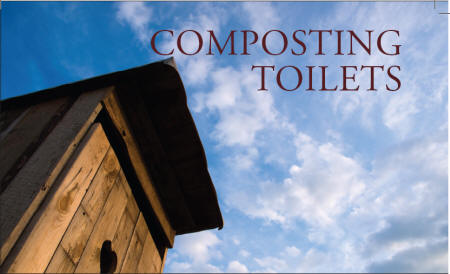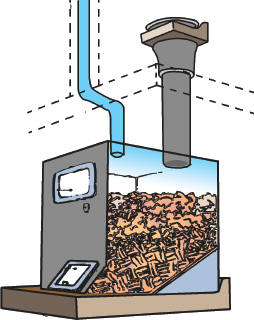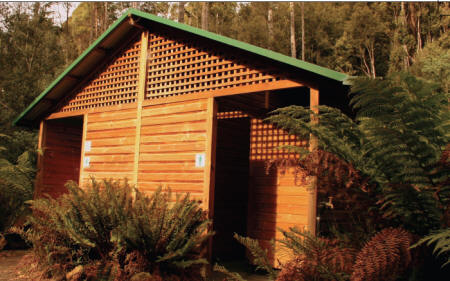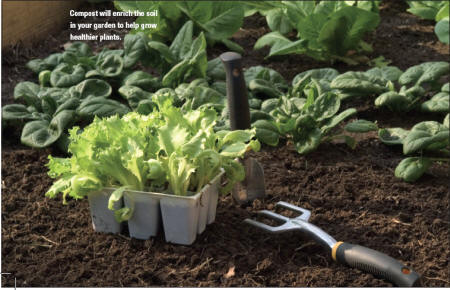
Toilets come in three common varieties: siphon-jet flush valve toilets (common in most homes), pressurized tank toilets, and gravity flow. These toilets, generally speaking, use up large amounts of water and the waste is flushed into a sewer system and then dumped in a variety of locations. Composting toilets require little to no water, which provides a solution to sanitation and environmental problems in areas that are rural, without sewers, and in the suburbs throughout the world. Although composting toilets are rare in private homes—they are generally found in park facilities and small highway rest stops—these waterless toilets can be utilized by the regular homeowner.
It is astonishing that Americans flush about 4.8 billion gallons of water down toilets every day, according to the U.S. Environmental Protection Agency. Just replacing all existing U.S. toilets with 1.6-gallon-per-flush, ultra-low-flow (ULF) models would save about 5,500 gallons of water per person per year! So, if you are unable to install a composting toilet in your home or on your property, you may choose to install ULF models in your home to help conserve water usage.
The Basics of the Composting Toilet
Composting (or biological) toilet systems contain and process excrement, toilet paper, carbon additive, and, at times, food wastes. These systems rely on unsaturated conditions where aerobic bacteria break down waste—unlike septic systems—much like a compost heap for your gardening necessities. The resulting soil-like material—humus—must be buried or removed. It’s a good idea to check state and local regulations regarding proper handling methods.
In many parts of the country, public health officials are realizing that there is a definite need for environmentally sound human waste treatment and recycling methods, and compost toilets are an easy way to work toward these needs. Because they don’t require any water, composting toilets are ideal for remote areas and places that have high water tables, shallow soil, and rough terrain. These systems save water and allow for valuable plant nutrients to be recycled in the process.
There are a few key components for establishing a composting toilet:
• Composting reactor that is connected to a micro-flush toilet
• Screened air inlet and exhaust system to remove odors and heat, plus CO2 and other decomposition byproducts
• Mechanism to provide proper ventilation that will help aerobic organisms in the compost heap
• Process controls
• Access door for the removal of the end product
It is important that the composting toilet separates the solid from the liquid waste and produces a humus-like material with less than 200 MPN per gram of fecal coliform. The compost chamber can be solar or electrically heated to maintain the right temperature for year-round use and bacterial decomposition.
Main Objective of the Composting Toilet
These systems are designed to contain, immobilize, and destroy pathogens. This reduces the risk of human infection and ensures that the toilets do not pollute the environment. If done correctly, the composted material can be handled with little to no risk of harming the individual working with it.
A composting toilet consists of a well-ventilated container that breeds a good environment for unsaturated, moist human excrement that can be decomposed under sanitary conditions. A composting toilet can be large or small, depending on the space and its use. Organic matter is transformed into a humus-like product through the natural breaking down from bacteria and fungi. Most systems like this use the process of continuous composting, which includes a single chamber where the excrement is added to the top and the end product is taken from the bottom.
Advantages of Using a Composting Toilet
Composting toilets can be used practically anywhere a flush toilet can be. They are most likely to be used in homes in rural areas, seasonal cabins, recreation areas, and other places where flush toilets are either unnecessary or impractical. They are more cost-effective than establishing a central sewage system and there is no water wasted. These systems— since they aren’t using copious amounts of water—also reduce the quantity of wastewater that is disposed of on a daily basis. These toilets can also be used to recycle and compost food wastes, thus reducing the amount of household garbage that is dumped every day. Finally, these toilet systems are beneficial to the environment as they divert nutrient and pathogen-containing effluent from the soil, surface water, and the groundwater.

Diagram of a composting toilet.
Disadvantages of Using a Composting Toilet
Composting toilets are a big responsibility; the owner of a composting toilet must be committed to maintaining the system. Removing the compost can be unpleasant if the toilet is not properly set up and they could end up having odor issues.

Composting toilets are being used more frequently in parks around the world.
Successful Management of the Composting Toilet
Composting toilets do not require highly trained people to deal with the sewage as it is relatively harmless to handle. But be sure to maintain your composting toilet so it can be effective and safe. Some composting toilets may need organic bulking agents added to aid the composting process. Adding grass clippings, sawdust, and leaves to your composting toilet reservoir will help aid the process. The end product should be removed every three months for smaller systems and, if composted correctly, should not smell and should not be toxic to humans or animals. Be sure to dispose of the waste materials in accordance with your particular state and local regulations.
Factors That Affect the Rate of Composting
1. Microorganisms—A mix of bacteria and fungi need to be present in order for the excrement to turn into composted material.
2. Moisture—This helps the microorganisms to make simpler compounds before they are metabolized. Moisture should be kept between 40 and 70 percent.
3. pH—The best pH for the composting toilet material should be between 6.5 and 7.5.
4. Carbon to nitrogen ratio—It is important to balance out the nitrogen found in urine with added carbon in your composting toilet.
5. Proper care—Managing your composting toilet well will help keep it efficient and productive.
Making Your Own Composting Toilet
Building your own composting toilet can be inexpensive and takes only a short amount of time to assemble. To construct a composting toilet, you will need the following materials:
• Two or three 5-gallon buckets with lids
• A standard toilet seat (a used one will work just fine) with lid
• ¾ x 3 x 18-inch plywood sheets
• Boards to be cut and used for the sides of the toilet box and for the legs
• Two hinges
• Screws
• Saw and measuring tape
• Bag of sawdust, to be used for soaking up excess moisture in the composting bucket
To begin, cut a hole in one of the pieces of plywood so that it fits the size of the bucket. Then, attach the pieces of plywood together using the hinges. Build a box with the boards and then screw in the solid piece of plywood to the box, allowing for the part with the hole to remain on the top. Attach legs to the box, allowing the bucket to lift just slightly above the hole cut in the top piece of plywood. Then, attach the toilet seat to the plywood top, fitting it securely over the rim of the bucket. Finally, stain or paint the entire composting toilet so it will last longer and match the décor of your bathroom.
Before using your homemade composting toilet, sprinkle 1 to 2 inches of sawdust into the bottom of the bucket. This will help absorb extra moisture and will also add a necessary carbon element that is useful in composting. Sprinkle sawdust into the toilet after each use to facilitate the composting process and to minimize odors. When the first bucket is full, remove and cover (allowing the composting process to continue), insert another bucket, and continue use. When both buckets are full, remove them to your composting pile in your yard. Make a small indent in the center of your composting pile and dump the new compost into the depression, laying old compost and other organic materials on top of the new addition. If used properly, your composting toilet will be odorless and your compost will be rich and ready for use in your garden.

Compost will enrich the soil in your garden to help grow healthier plants.